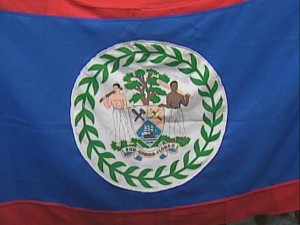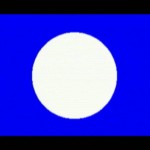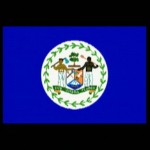A look back at the history of our Belizean flag
 The national flag is a symbol of nationhood and unity. It was first unfurled at midnight on September twenty-first, 1981as Belize became an independent nation. The flag’s design was the work of the National Symbols Committee which received submissions from the public. But over the years, there have been changes to the red, white and blue standard. Aside from the variations in the colors, the most recent departure from the original design can be found in the coat of arms, which, these days, is the subject of lively debate. This piece, done in 2009 by News Five’s Marion Ali, traces the history of the flag.
The national flag is a symbol of nationhood and unity. It was first unfurled at midnight on September twenty-first, 1981as Belize became an independent nation. The flag’s design was the work of the National Symbols Committee which received submissions from the public. But over the years, there have been changes to the red, white and blue standard. Aside from the variations in the colors, the most recent departure from the original design can be found in the coat of arms, which, these days, is the subject of lively debate. This piece, done in 2009 by News Five’s Marion Ali, traces the history of the flag.
Marion Ali, Reporting
The flag we salute today at the sound of “Land of the Free” was introduced on September twenty first, 1981. It is the result of decades of input by many Belizeans from both sides of the political fence.
 The flag went thru many changes dating back to 1950. The civilian flag, also called the Baymen’s flag, had a blue background and a white disk in the centre. It was introduced on February second, after the first political party, the People’s United Party, was formed.
The flag went thru many changes dating back to 1950. The civilian flag, also called the Baymen’s flag, had a blue background and a white disk in the centre. It was introduced on February second, after the first political party, the People’s United Party, was formed.
But in 1967, this more detailed flag with the coat of arms was adopted after the then British Honduras gained self government in 1964. W Crampton wrote in the book, Flags of the World in 1978, that the flag was used only on land.
 It was not flown as the official flag because the settlement was a British territory and the official flag was the Union Jack. But just prior to our attainment of Independence, a Committee was set up to design the National flag, and after some minor changes to the original emblem, the final masterpiece was submitted. The main colors are royal blue, red and white. The red borders the top and bottom were added to include the colors of the existing political parties at the time. This letter dated February first, 1982 and signed by the York Herald of Arms in England, Conrad Swan, states in detail the features of the Coat of Arms.
It was not flown as the official flag because the settlement was a British territory and the official flag was the Union Jack. But just prior to our attainment of Independence, a Committee was set up to design the National flag, and after some minor changes to the original emblem, the final masterpiece was submitted. The main colors are royal blue, red and white. The red borders the top and bottom were added to include the colors of the existing political parties at the time. This letter dated February first, 1982 and signed by the York Herald of Arms in England, Conrad Swan, states in detail the features of the Coat of Arms.
 The Coat of Arms consists of a shield that is divided into three sections. At the base, a ship is in full sail, which represents the mode of our trading. At the two upper sections are tools once used in the timber industry in Belize. Those include a paddle and a beating axe on the left and on the right – a saw and a squaring axe. Supporting the shield are two woodcutters dressed only in long white trousers and standing on grass. The Mestizo man on the left is holding another squaring axe over his right shoulder, while the black man on the right is holding a paddle over his left shoulder. Above the shield rises a mahogany tree and below is the motto scroll “Sub Umbra Floreo”, which when translated from Latin reads “Under the Shade I Flourish”. A wreath of fifty leaves locally called “Scorn the Earth” encircles the Coat of Arms. The fifty leaves signify the year 1950, when the first flag was presented.
The Coat of Arms consists of a shield that is divided into three sections. At the base, a ship is in full sail, which represents the mode of our trading. At the two upper sections are tools once used in the timber industry in Belize. Those include a paddle and a beating axe on the left and on the right – a saw and a squaring axe. Supporting the shield are two woodcutters dressed only in long white trousers and standing on grass. The Mestizo man on the left is holding another squaring axe over his right shoulder, while the black man on the right is holding a paddle over his left shoulder. Above the shield rises a mahogany tree and below is the motto scroll “Sub Umbra Floreo”, which when translated from Latin reads “Under the Shade I Flourish”. A wreath of fifty leaves locally called “Scorn the Earth” encircles the Coat of Arms. The fifty leaves signify the year 1950, when the first flag was presented.
O ne ensign that proved to be far bigger than even the acts of terrorism is this flag which was flown at the World Trade Centre on September eleventh, 2001. It is one of the few that were discovered after the tragedy and although damaged, it is permanently on display at the Museum of Belize. Curator at the Museum, Teresa Batty, says it was salvaged by a Belizean at the site.
ne ensign that proved to be far bigger than even the acts of terrorism is this flag which was flown at the World Trade Centre on September eleventh, 2001. It is one of the few that were discovered after the tragedy and although damaged, it is permanently on display at the Museum of Belize. Curator at the Museum, Teresa Batty, says it was salvaged by a Belizean at the site.
Teresa Batty, Curator, Museum of Belize
“It was a Belizean who was assisting with volunteering and the person found the flag and turned it in then the Fire Service from New York gave it to our Belize Mission in New York. So it was donated to the Museum when we were launched in 2002. It has lots of holes, still dirty as it came but for us it’s important. When you look at it you can see all the holes, but it survived.”
Perhaps its fate is a lesson that we as a people can learn from. Reporting for News Five, Marion Ali.


Very nice n very educating. Great job Mar.
We still need to……………………….. STAND AND PUT OUR HANDS ON OUR HEARTS…………. as we sing THE NATIONAL ANTHEM.